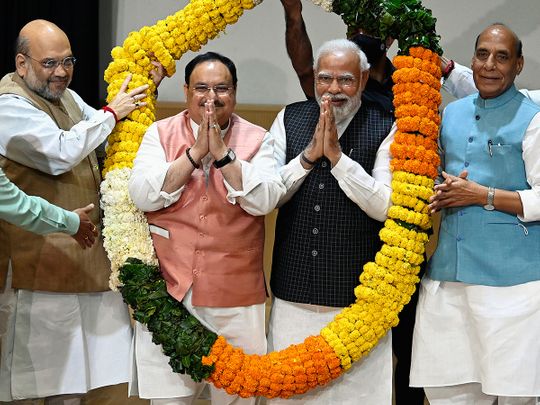
In India, the Bharatiya Janata Party (BJP) celebrated its 42nd Foundation Day in style last week, with the Prime Minister leading the way and highlighting the party’s successes from the recent victories in UP and other states in the assembly polls and the fact that the BJP has now touched 100 MPs in the upper house of Parliament, the Rajya Sabha, the first for any party in 30 years.
From only 2 MPs in the Lok Sabha in 1984, it was only in 1991 that the BJP crossed the 100 mark in the lower house. Fast forward to 2014, and the Modi wave brought the BJP lead NDA 300 plus seats which was repeated in 2019. Today, there are BJP governments in 12 states and they are in power with NDA allies in 6 more.
India's main opposition party, the Congress, has been reduced to just 2 states- Rajasthan and Chhattisgarh while the only regional party to have chief ministers in 2 states is Arvind Kejriwal’s Aam Aadmi Party (AAP), making it a possible principle future challenger.
On the face of it, Modi’s BJP appears invincible. Hours after the assembly poll victory in March, the Prime Minister was quick to declare that the 2024 general election was a done deal.
But is it?
There is no doubt that the BJP is in pole position for 2024. And to attribute it only to polarisation would be foolish. Yes, the controversy around hijab, halal and abba jaan are a contributing factor to the party’s victories but as UP election results showed, this Hindutva politics combined with social welfare schemes have driven the BJP further.
But no one is invincible.
After the 2014 win, the same was said of the BJP then. But the party went on to lose a string of state elections- Bihar, Madhya Pradesh, Chhattisgarh, Rajasthan, Bengal - to name a few. It got a scare in Gujarat in the last assembly poll.
Strong in Hindi heartland
The party’s strength largely lies in the Hindi heartland. In 2014, of the 225 seats in the Hindi Heartland, the BJP had won 190 seats with a vote share of 41%. Here too, it has not been invincible as the defeats in Rajasthan, Chhattisgarh and MP showed, along with a sub par performance in Haryana.
But when you travel outside this space, the picture is even more interesting in the remaining 300 plus Lok Sabha seats. Tamil Nadu, Kerala, Telangana, Andhra Pradesh, Maharastra, Orissa, Jharkhand, Punjab, Delhi,Rajasthan and Chhattisgarh are all governed by powerful regional parties and the Congress.
Perhaps that is why senior Congress leader P Chidamabaram told me in an interview recently that the next general election would have to be fought by the opposition state by state and that the Congress would have to concede space to allies and take a back seat, including to the AAP.

The other key factor for the opposition would be to win over a significant part of the Hindu vote and women voters. It is this vote that the BJP seeks to consolidate and it holds the key to their election wins.
Data shows that more women voted for the BJP in UP than for the SP, though the gap may not be very much, perhaps 2 percent or so.
Women voters were key to Mamata Banerjee’s Bengal win as well. For regional parties, this means traditional vote banks of say Muslims and Yadavs alone won’t cut it any more. They have to fight the BJP for the Hindu vote too.
It is also true that as national elections have become more presidential in style, Narendra Modi remains the BJP’s biggest asset.
Rahul Gandhi clearly is not the face the opposition can rely on and there are too many claimants to the top job in the opposition camp. That makes it advantage Modi.
To defeat Modi, the opposition would have to do some clever politics that goes beyond simple arithmetic. Can they?













